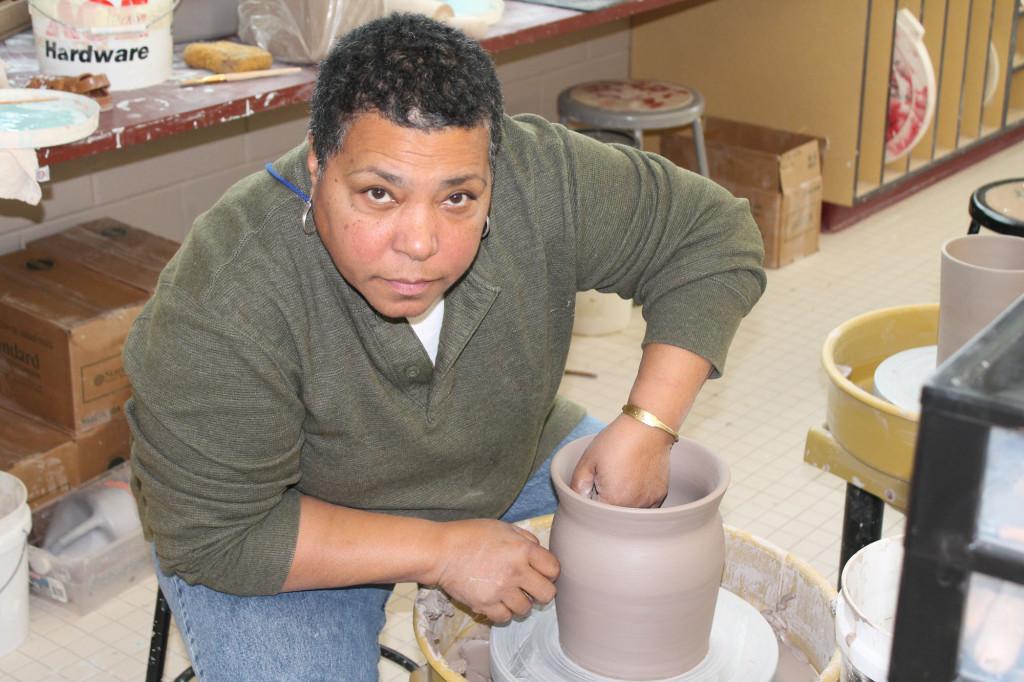ART All Around Us
A Closer Look at Ceramics
Ms. Norris demonstrates “throwing” on the potter’s wheel, gradually pulling the walls of the pot upward to make the piece grow in height.
Ceramics at Paint Branch High School is an art class that allows students to design and build pieces of art made out of clay.
Taught by Ms. Norris, the class focuses on showing students how to make anything they want out of clay. From bowls to pots, plates to birds, dragons to turtles, you can make whatever your imagination leads you to make in ceramics.
Regarding what students make in ceramics, Ms. Norris says, “There are specific assignments that students must complete, however – after reaching a certain level of craftsmanship, especially in advanced ceramics – students are encouraged to create a ‘body’ of work as a professional artist would. They are encouraged to use their imagination, combined with their skill, to discover their voice.”
Ms. Norris, who has been a ceramics teacher at Paint Branch High School for eight years, is the head of the Visual Arts Department. Ms. Norris is not only trained and educated in ceramics but also in painting, which is what she actually studied in college. Ms. Norris, who calls herself an “all-around artistic person,” enjoys expressing her love for art through her job and her students.
Ceramics are objects made of clay that are transformed through firing. You can either hand-build an object you want to develop by molding together pieces of clay, or you can “throw” pots and plates and bowls on the potter’s wheel. “Throwing” something is a pottery term for making pots on a wheel and throwing the clay with your hands – basically molding it on the spinning wheel. Most people find the potter’s wheel to be the more difficult skill, but both skills require patience and a significant amount of trial and error to master.
Four different levels of ceramics are offered at Paint Branch, starting with Ceramics 1 – a class where students are introduced to the five basic techniques for working with clay as well as ceramics tools, terms, and process. According to Ms. Norris, “through a variety of projects, students develop those skills as they create functional as well as decorative works, in a communal class environment where students are encouraged to learn from one another.”
Ceramics 1 student Amelia Harmon enjoys her ceramics class because, “I like making things and creating things with my hands.” The junior is quick to add that she also enjoys the class’ atmosphere, “It’s also a good period to chill, even though you actually have to work.”
After successfully completing Ceramics 1, students may sign up for Ceramics 2, where they continue to learn the skills of ceramics but at a slightly higher and more challenging level. Ultimately, the curriculum for each year is relatively similar, consisting of independent projects in addition to assigned projects that become more challenging as you progress in your study of ceramics. Students are expected to exhibit development with each piece they make, learning and understanding the tricks to making nicer and more refined work.
As for mastering the class material, Ms. Norris states with a smile, “Once you know the basics of ceramics, it only takes a lifetime to master.”
Grading varies, depending on the level you are studying. In the upper-level classes – beyond Ceramics 1 – students receive grades on the quality of their work and their ability to complete strong pieces. While Ms. Norris has a rubric that focuses on important skills such as conceptual development, technical skill (craftsmanship), and visual organization, she admits that much of what a student earns in the class is what s/he puts into it.
“We have a difficult grading challenge in Art because of the mixture of grades 9 through 12,” says Ms. Norris. “I tell students that they are not competing with anyone else in the class, that what I want to see is their personal development as an artist between September and June that can only come with a commitment to do their best. Once you know the basics, then the class becomes a journey of exploring how to marry your craftsmanship to your personal vision or your interpretation of an assignment.”












































